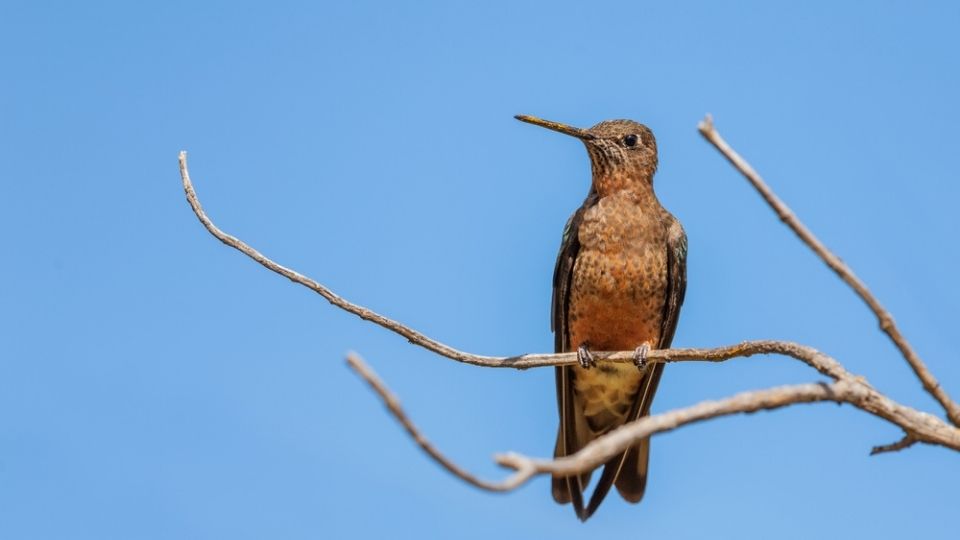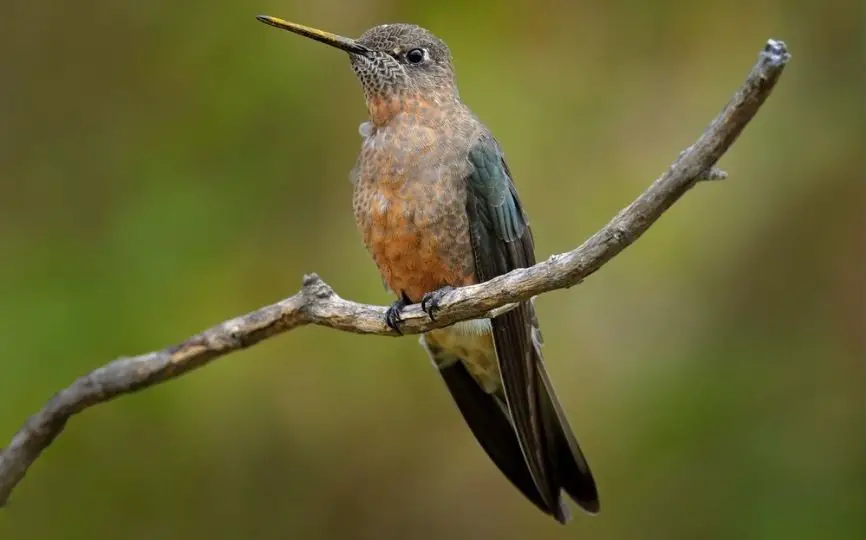The Giant hummingbird Patagona Gigas is also called Colibrí Gigante or Picaflor Gigante. It has a variety of names, depending on the language. They’re part of the order Apodiformes, the family Trochilidae, and the genus Patagona, that is part of the Andean clade.
Hummingbirds are part of the Trochilidae family, and there are more than 300 hummingbird species in the world today. Hummingbirds come in all types, shapes, and colors. There is so much variation that it can be a challenge sometimes to tell them apart.
But some you can recognize more quickly because they stand out the most. An example is the Giant hummingbird. They are split into two subspecies, P. gigas gigas and P. gigas peruviana. They have a wingspan of about 21.5 cm.
In contrast, the bee hummingbird (Mellisuga or Calypte, helenae) is the smallest bird species in the world, having a total length of 5.5 cm, bill and tail included, and weighing about 2 grams. In comparison, the giant hummingbird is the largest hummingbird in the world. It sports a size of no less than 20-22 cm and a weight of 18-23 g—lower than you might expect from such a big bird.
Table of Contents
The giant hummingbird habitat
You can spot sightings of Giant hummingbirds in the Andes of southwestern Colombia, South America, and see them at 2,000 to 4,300 meters above sea level. They generally prefer higher altitudes in the summer and spend their time in dry habitats. More specifically, you can spot several in arid mountain scrubs, brushy canyons, and around mountain streams.
Distribution of subspecies:
You can find Patagona gigas peruviana in Ecuador and the mountains of Peru. This subspecies has long wings and bills than the other type.
You can find Patagona gigas gigas in Chile, Bolivia, and Argentina. You can see this species a lot in the Sierras Grandes de Cordoba.

Giant hummingbird behavior
Hummingbirds are generally solitary creatures, and the Giant Hummingbird is no exception. They prefer to hover and travel alone and don’t mate for life. They are highly territorial and have even been known to become aggressive when defending their foraging area.
However, they can fall prey to bigger birds like the Andean Condor. Remember, they’re the largest bird. Although, that’s from a family of already small birds.
Giant hummingbird reproduction
Breeding season beginning time varies across locations:
- In Ecuador, it starts December and ends in March.
- In Chile, it starts in October and ends in January.
- In Peru, it starts in September and ends in March.
When the breeding season begins, males Giant hummingbirds perform “U” shaped courtship dives to impress the females. A male usually courts and mates with multiple partners during this mating season.
After it all passes, females Giant hummingbirds do everything on their own. This includes building the nest, incubating, and caring for the babies. The babies usually leave the nest after about 20 days.
The nest of the Giant hummingbird is more extensive than that of other hummingbirds, which is expected. It usually has about 20cm in length and is 15cm tall. As you might have guessed, their eggs are also larger.
What does the Giant hummingbird eat?
Giant hummingbirds are highly efficient pollinators, so they eat a lot of nectar. They typically favor tube-shaped flowers. Some examples of their favorites include Agave, Passiflora, Eucalyptus, Puya, and Buddleia.
They also eat plenty of small insects like gnats, spiders, and fruit flies. These are a perfect protein source. There have been instances where the giant hummingbird was caught eating minerals rich in calcium—like wood ashes and slaked lime.
You can attract the Giant hummingbird to your yard by placing hummingbird feeders in your garden. Just make sure to fill them with nectar. To make your nectar, combine four parts of water with one part of sugar.
Giant hummingbird appearance
The Giant hummingbird had a green and grey back, wings, and tail with a white rump and white tail edges. There is some variability from one bird to another (and from males to females). Sometimes they have rufous, grayish, or red underparts.
Their long bill is black and straight. They have a white patch around their eyes. The female Giant hummingbird typically has duller plumage.
The thing that makes them markedly stand apart from others is, as you would expect, their size. Their feet and wings are bigger than usual, but you’ll also notice that they are slower than any other hummingbird.

Facts about the Giant hummingbird
- Their conservation status is not of concern, according to the Threatened and Endangered list of IUCN. Urbanization and agricultural activities have affected them very little, compared to other hummingbirds.
- The Giant hummingbird is more lightweight than its other giant counterparts.
- They have a particular sound. It’s short, loud, and squeaky.
- You can hear their sounds here (you can read the context in which the recordings were made).
- The Giant hummingbird hovers at only 15 wing beats per second, less than other hummingbirds. They also hover significantly less when going from flower to flower, making good use of perches.
Giant Hummingbird Summary
The Giant hummingbird is an example of what size hummingbirds can reach! There is no other bigger hummingbird, and there probably will never be. But even for a giant hummingbird, this species is still considered small among birds.
Even if their plumage is less spectacular than other hummingbirds, we still think they have impressive qualities that stand out! So if you want to browse more info on the Giant Hummingbird, head to Birds of the World for more ornithological resources on these jewels.

